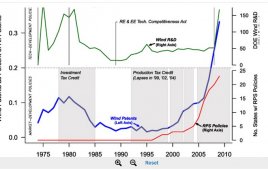A new study estimates that $2.2 billion in benefits came from reduced greenhouse gas emissions and $5.2 billion from reductions in other air pollution for state renewable portfolio standard (RPS) policies operating in 2013.
RPS policies are driving wind turbine innovation
Nathaniel Horner, doctoral student, Engineering and Public Policy Department, Carnegie Mellon University In a nutshell: the significant increase in wind turbine patenting activity in the last decade has coincided with the adoption of state-level renewable portfolio standards or RPSs in the U.S. Conversely, the production tax credit – while a strong incentive for turbine construction…
Defending RPSs and driving demand for a new wind vision
Panelists had a lot to say at the recent AWEA Fall Symposium. The first session dealt with ides for driving demand for wind power, such as lower generation costs, wind power as a natural hedge against rising natural-gas prices, and competition as a way to generate more renewable energy. The panel chaired by Robert Crowell,…
Ohio senator suggests the wrong road for renewable energy
Narrow minds and shortsightedness are the bane of the wind industry. The afflictions have surfaced again in a bill to repeal the Ohio mandate for utilities to find 25% of their power from renewable and so-called “advanced-technology” sources by 2025. The current law states half of the mandate, 12.5%, must come from renewable sources such…
California signs 33% renewable portfolio standard into law
By Dian Grueneich and Theresa Cho, Morrison & Foerster Reaffirming California’s commitment to the development and use of renewable energy sources, Governor Jerry Brown recently signed Senate Bill X1 2, which requires all California utilities to generate 33% of their electricity from renewables by 2020. The new 33% renewable portfolio standard (RPS)—the most ambitious in…
President Obama leans toward national renewable energy
Approximately two months ago, the energy industry in the United States ran into some serious turbulence. The semi-submersible Deepwater Horizon rig exploded, killing 11 and unleashing anywhere between 20,000 and 40,000 gallons of crude oil into the Gulf of Mexico. Since that day, rig owner BP plc has made multiple attempts to stop the oil…




